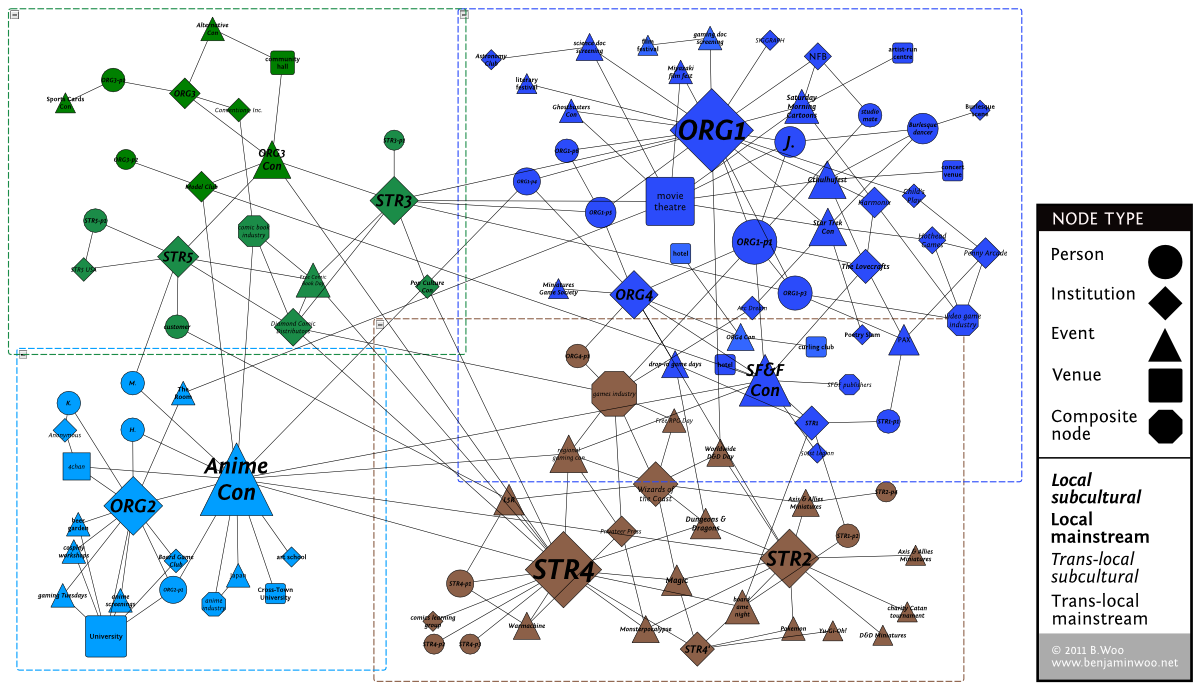In my research on nerd culture, I have been trying to distinguish between, on the one hand, an understanding of subculture as a kind of identity position or “imagined community” (Anderson 1983) and, on the other hand, a “subcultural scene.” The distinction here is between an abstract and trans-local field (the subculture) and a concrete, localized milieu within which individual participants pursue their cultural practices. In this post, I want to say a bit more about (sub)cultural scenes.
Scenes and Communities in Popular-music Studies
Although the the term is one that is widely used in ordinary language, I’ve borrowed it more directly from popular music studies, where its currency can be traced to a handful of essays written over the last twenty years by McGill’s Will Straw (1991, 2002, 2004). Since Straw introduced it to the discipline, “scene” has become one of its distinctive theoretical concepts (Anahid Kassabian quoted in Hesmondhalgh 2005, 27).
For Straw, the notion of “scene” is a departure point from an older conception of “musical communities.” Although it is only vaguely defined in popular use, denoting a objects ranging from “highly local clusters of activity” to globally dispersed taste cultures, yet the term “persists within cultural analysis for a number of reasons”:
One of these is the term’s efficiency as a default label for cultural unities whose precise boundaries are invisible and elastic. “Scene” is usefully flexible and anti-essentializing, requiring of those who use it no more than that they observe a hazy coherence between sets of practices or affinities. For those who study popular music, “scene” has the capacity to disengage phenomena from the more fixed and theoretically troubled unities of class or subculture (even when it holds out the promise of their eventual rearticulation). At the same time, “scene” seems able to evoke both the cozy intimacy of community and the fluid cosmopolitanism of urban life. To the former, it adds a sense of dynamism; to the latter, a recognition of the inner circles and weighty histories which give each seemingly fluid surface a secret order. (2002, 248)
The idea of community “presumes a population group whose composition is relatively stable—according to a wide range of sociological variables—and whose involvement in music takes the form of an ongoing exploration of one or more musical idioms said to be rooted within a geographically specific historical heritage” (1991, 373), and such a conception is no longer tenable (if, indeed, it ever was) given the globalization of musical forms. A scene, by contrast, is a more fluid and changeable cultural space characterized by “the building of musical alliances and the drawing of musical boundaries” (1991, 373). More recently, Straw has expanded his definition of scenes beyond musical practices to embrace “particular clusters of social and cultural activity without specifying the nature of the boundaries which circumscribe them” but which may be distinguished by location, genre, or “the loosely defined social activity around which they take shape” (2004, 412).
This understanding of a cultural scene is an important corrective to some of the "fetishizing" tendencies in subculture theory that I have discussed elsewhere. Subcultures researchers have too often mistaken their own Platonic idea of a subculture (mod or goth or punk or whatever) for an actually existing reality. Rather, such ideal "subcultures" are accepted, rejected, appropriated, negotiated, and adapted by participants in an on-going practice (or set of practices). However, these practices are socially situated: They take place in a local context where some resources are available and others are scarce, where some opportunities for participation are abundant and others rare. This more or less geographically bounded context is what I am calling, borrowing from Straw, a subcultural scene.
The Nerd-culture Scene
This concept is both theoretically and methodologically important to how I'm approaching my study of nerd culture. My research up until this point has been trying to explore the nerd-culture scene in one Canadian city from the point of view of specialty retailers and non-profit fannish organizations. As may be seen from the following figure, the nerd-culture scene is highly interconnected at the level of stores and organizations. Research sites sites were connected with one another and with other local and trans-local actors by relationships of patronage, cross-promotion, and sponsorship.
This graph was produced using yEd, a multi-purpose graph editing application. Nodes and connections were entered from interviews and fieldnotes, and connections are not weighted. yEd’s organic layout, natural clustering, and automatic grouping algorithms were used to organize the representation of the scene. Icon size represents centrality, measured in terms of number of connections.
Observed relationships among participants and institutions divide the field into four major clusters or sub-fields:
- The largest cluster (in the upper right) is dominated by nerdy film society ORG1, its president ORG1-p1, and the local SF&F convention, and so this might be considered the field of media fandom, although gamers' networking portal ORG4, game shop STR2, and nodes associated with video games also appear in this region of the graph.
- The second cluster (bottom right) comprises game shops STR2 and STR4, as well as the many games that both stores support with regular events. ORG4-p1’s inclusion and the numerous games-industry members who sponsor ORG1 events draw this cluster as a whole closer to the first field.
- The third grouping (upper left) was constructed by combining two smaller clusters, denoted by the two different shades of green. They both dealt primarily with comic books but separated ORG3 and its conventions from the retail stores, STR3 and STR5.
- The fourth and final field (bottom left) mainly deals with anime fandom. Although anime fans might logically be considered a sub-field of the broader media-fandom field, the clustering and grouping of observed relations suggests that it constitutes a relatively distinct, parallel fan community. University club ORG2 also embraces gaming activities, but these appear to be largely unconnected with the wider gaming communities within the scene.
One way of understanding a subcultural scene, then, is as a nexus of niches. The relationships mentioned by interviewees and directly observed during fieldwork are presumably only a small fraction of the total ties that bind the scene together (especially with respect to participant mobility between events and stores), and so the figure is incomplete. Nonetheless, it helps substantiate the intuition that consumption within the context of practices can never be entirely private and dispersed. The simple transactions required to access or acquire the objects of their interests implicate consumers in a complex and fluid network of relationships. Some of these are known or potentially knowable; others are hidden but no less influential for their obscurity. The inevitability of these relationships gives force to the sense of nerd culture as a scene.
References
Anderson, Benedict. 1983. Imagined Communities: Reflections on the Origin and Spread of Nationalism. London: Verso.
Hesmondhalgh, David. 2005. "Subcultures, Scenes or Tribes? None of the Above." Journal of Youth Studies 8 (1): 21–40.
Straw, Will. 1991. "Systems of Articulation, Logics of Change: Communities and Scenes in Popular Music." Cultural Studies 5 (3): 368–88.
———. 2002. "Scenes and Sensibilities." Public 22/23: 245–257.
———. 2004. "Cultural Scenes." Loisir et societe/Society and Leisure 27 ,(2): 411–422.

